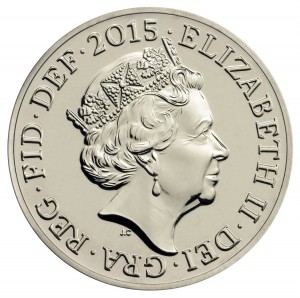February 26-March 4, 2015, Current Events Lesson Plan
Current Event: New Face for British Coins
The National Portrait Gallery in London recently unveiled a new portrait of Queen Elizabeth II that will be used on the front side of coins struck by the Royal Mint. This portrait is the fifth to be created for Elizabeth II, who has reigned since 1952. The first image was struck in 1953, the year of Elizabeth’s coronation. It shows a very young queen wearing a laurel wreath. This image is still used today on Maundy money (money distributed by the queen on Maundy Thursday, the day before Good Friday). The most recent portrait shows a mature queen wearing the diamond diadem (crown) she wore at her coronation and a small smile.

A 2015 £1 coin bearing the fifth definitive coin portrait of Queen Elizabeth II (Credit: The Royal Mint)
Objective:
Money is anything accepted by members of a community in exchange for the things they sell or the work they do. In ancient times, people used such items as beads, cacao beans, shells, and stones as money. Later, governments created the longest-lived monetary object in the history of the world—the coin. Early coins developed independently in three places—China; India; and Lydia, an ancient kingdom in western Turkey. People in Lydia made coins by the 600’s B.C. These coins were made of precious metals—usually gold, silver, or a mixture of the two called electrum. The date of the invention of Chinese coins is difficult to establish. Historians know, however, that people in China produced coins by the time coins developed independently in Lydia. The first Chinese coins were shaped like miniature spades and knives—valuable tools in a farming society. The concept of coins may have come to India as early as the 500’s B.C. Like Lydian coins, most Indian coins were made of precious metals. At one time, coins were made of a precious metal that, taken with the cost of manufacturing the coin, equaled the coin’s stated value. In the United States and Europe, such coins were made of gold. Most nations, including the United States, phased out the use of gold coins in the 1930’s as a response to the worldwide economic slump called the Great Depression. The Behind the Headlines news story and related World Book articles explore money from around the world.
Words to know:
Discussion Topics:
1. Ask your students to name currencies from around the world. (Students might say the dollar [Australia, Canada, United States]; euro [many European countries]; pound [United Kingdom]; ruble [Russia]; shekel [Israel]; yen [Japan]; yuan [China].)
2. Coin collecting is a popular hobby. Ask your students to name other things people collect. (Students might say autographs, baseball cards, books, comics, stamps.)
3. Ask your students to debate, “All countries should use the same currency.”
4. Ask your students to use World Book’s Timelines feature to create a timeline of the history of money. (Students may wish to use World Book’s Money article for help.)


